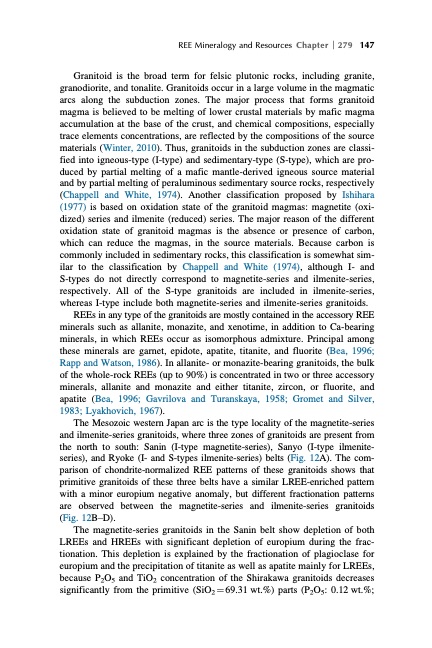
PDF Publication Title:
Text from PDF Page: 183
REE Mineralogy and Resources Chapter 279 147 Granitoid is the broad term for felsic plutonic rocks, including granite, granodiorite, and tonalite. Granitoids occur in a large volume in the magmatic arcs along the subduction zones. The major process that forms granitoid magma is believed to be melting of lower crustal materials by mafic magma accumulation at the base of the crust, and chemical compositions, especially trace elements concentrations, are reflected by the compositions of the source materials (Winter, 2010). Thus, granitoids in the subduction zones are classi- fied into igneous-type (I-type) and sedimentary-type (S-type), which are pro- duced by partial melting of a mafic mantle-derived igneous source material and by partial melting of peraluminous sedimentary source rocks, respectively (Chappell and White, 1974). Another classification proposed by Ishihara (1977) is based on oxidation state of the granitoid magmas: magnetite (oxi- dized) series and ilmenite (reduced) series. The major reason of the different oxidation state of granitoid magmas is the absence or presence of carbon, which can reduce the magmas, in the source materials. Because carbon is commonly included in sedimentary rocks, this classification is somewhat sim- ilar to the classification by Chappell and White (1974), although I- and S-types do not directly correspond to magnetite-series and ilmenite-series, respectively. All of the S-type granitoids are included in ilmenite-series, whereas I-type include both magnetite-series and ilmenite-series granitoids. REEs in any type of the granitoids are mostly contained in the accessory REE minerals such as allanite, monazite, and xenotime, in addition to Ca-bearing minerals, in which REEs occur as isomorphous admixture. Principal among these minerals are garnet, epidote, apatite, titanite, and fluorite (Bea, 1996; Rapp and Watson, 1986). In allanite- or monazite-bearing granitoids, the bulk of the whole-rock REEs (up to 90%) is concentrated in two or three accessory minerals, allanite and monazite and either titanite, zircon, or fluorite, and apatite (Bea, 1996; Gavrilova and Turanskaya, 1958; Gromet and Silver, 1983; Lyakhovich, 1967). The Mesozoic western Japan arc is the type locality of the magnetite-series and ilmenite-series granitoids, where three zones of granitoids are present from the north to south: Sanin (I-type magnetite-series), Sanyo (I-type ilmenite- series), and Ryoke (I- and S-types ilmenite-series) belts (Fig. 12A). The com- parison of chondrite-normalized REE patterns of these granitoids shows that primitive granitoids of these three belts have a similar LREE-enriched pattern with a minor europium negative anomaly, but different fractionation patterns are observed between the magnetite-series and ilmenite-series granitoids (Fig. 12B–D). The magnetite-series granitoids in the Sanin belt show depletion of both LREEs and HREEs with significant depletion of europium during the frac- tionation. This depletion is explained by the fractionation of plagioclase for europium and the precipitation of titanite as well as apatite mainly for LREEs, because P2O5 and TiO2 concentration of the Shirakawa granitoids decreases significantly from the primitive (SiO2 1⁄4 69.31 wt.%) parts (P2O5: 0.12 wt.%;PDF Image | HANDBOOK ON THE PHYSICS AND CHEMISTRY OF RARE EARTHS

PDF Search Title:
HANDBOOK ON THE PHYSICS AND CHEMISTRY OF RARE EARTHSOriginal File Name Searched:
Chemistry-Rare-Earths-49.pdfDIY PDF Search: Google It | Yahoo | Bing
Sulfur Deposition on Carbon Nanofibers using Supercritical CO2 Sulfur Deposition on Carbon Nanofibers using Supercritical CO2. Gamma sulfur also known as mother of pearl sulfur and nacreous sulfur... More Info
CO2 Organic Rankine Cycle Experimenter Platform The supercritical CO2 phase change system is both a heat pump and organic rankine cycle which can be used for those purposes and as a supercritical extractor for advanced subcritical and supercritical extraction technology. Uses include producing nanoparticles, precious metal CO2 extraction, lithium battery recycling, and other applications... More Info
| CONTACT TEL: 608-238-6001 Email: greg@infinityturbine.com | RSS | AMP |